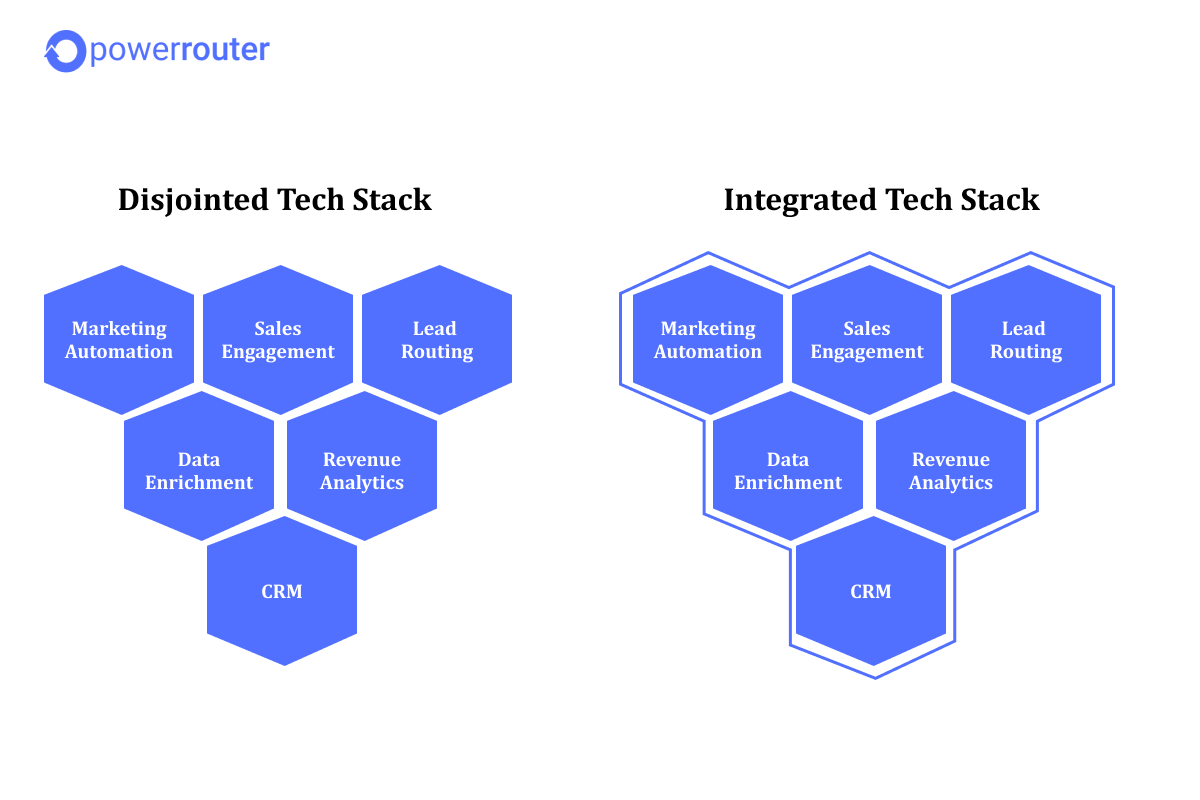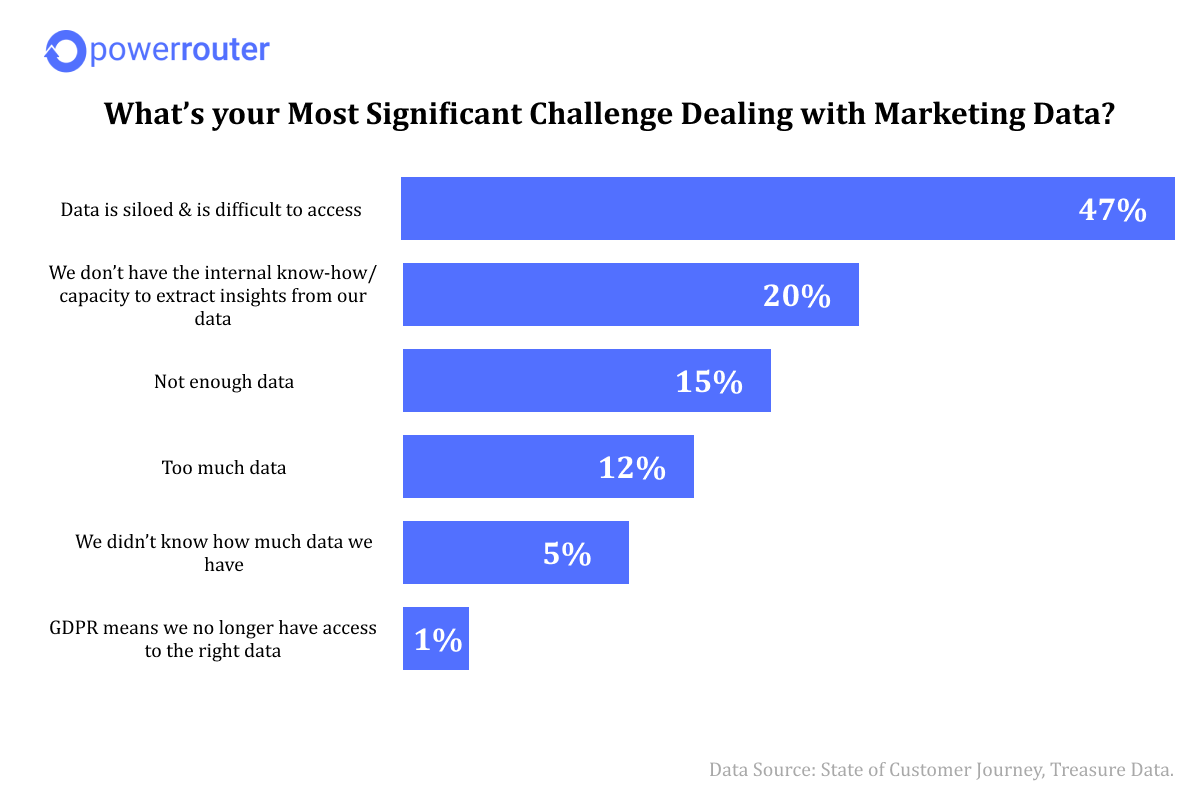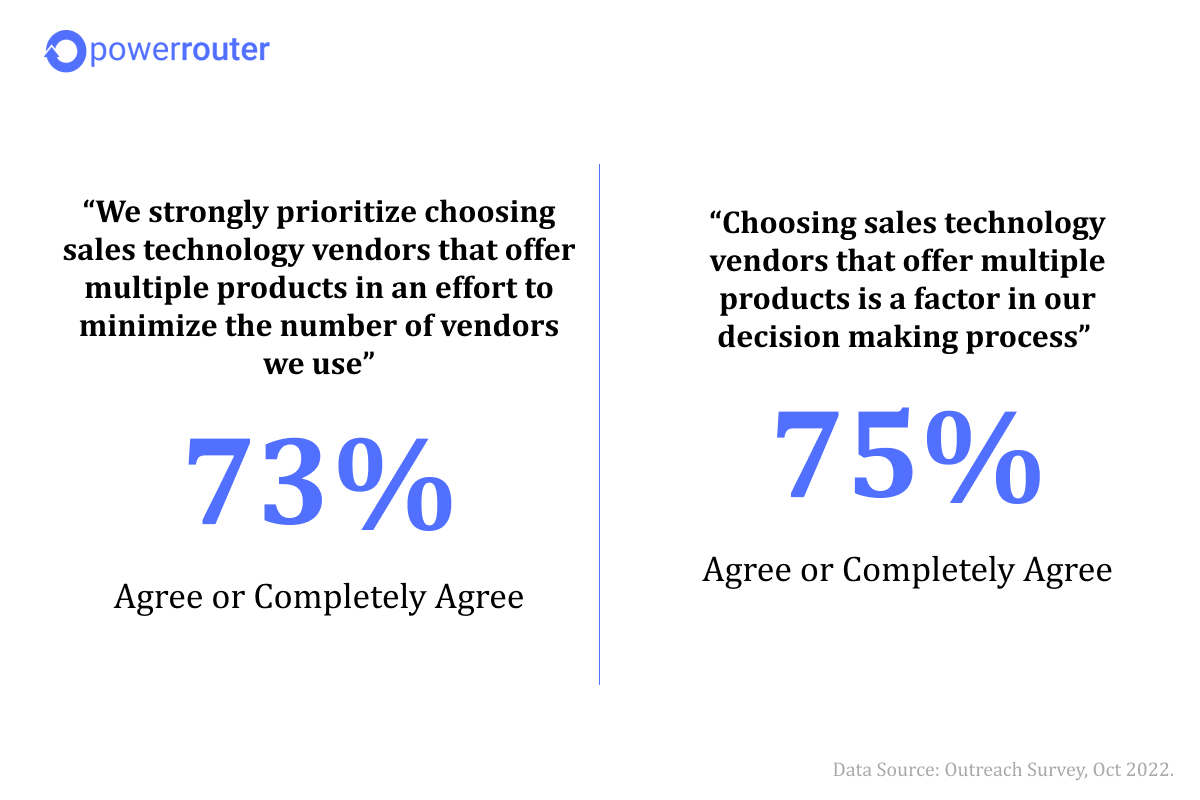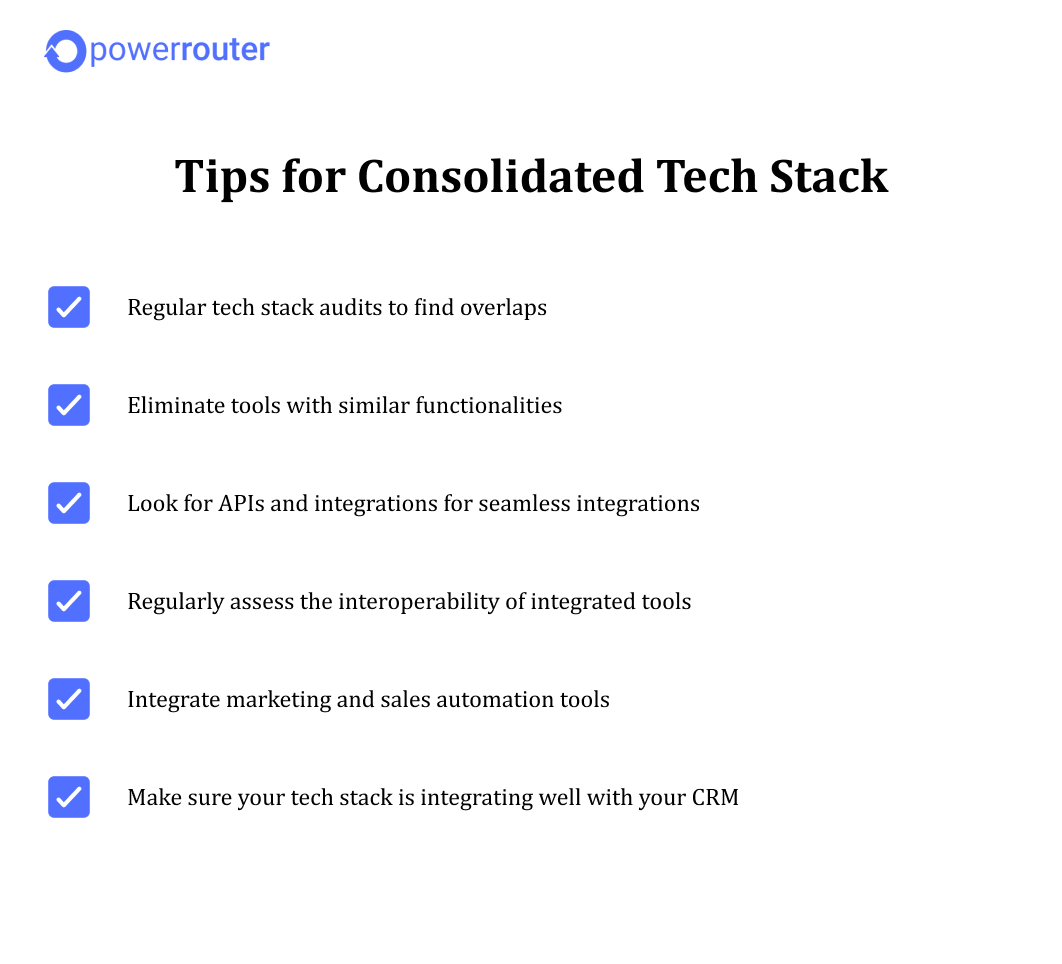Sales teams use an average of 10 different tools. Regardless of the exhaustive tech stack, they end up using only 62% of it yet spend a mere 27% of their time selling.

Sales tech stacks are often disconnected. A disjointed tech stack creates silos in your buyer journey, impacting your buyer experiences and sales success.
However, the reality is there’s no one revenue tool to consolidate your customer data and streamline your revenue operations. As enterprise data grows at an annual growth rate of 42%, it’s imperative to end the data silos for better revenue efficiency.
Buckle up as we discuss the impact of a disjointed tech stack on your revenue funnel and tips to consolidate your tech stack.
What is a Disjointed Tech Stack?
A disjointed sales tech stack refers to a collection of sales tools and technologies that lack integration, coordination, and seamless connectivity. In a disjointed sales tech stack, different tools and systems are often used in isolation, with limited or no interoperability between them. This disjointed state leads to data fragmentation, inefficiencies, duplicated efforts, and a lack of visibility and collaboration across sales processes. The result is a fragmented and disconnected sales ecosystem that hampers productivity, inhibits effective decision-making, and diminishes the overall effectiveness of sales operations.

Impact of Disjointed Tech Stack on your Revenue Funnel
Siloed Data
Over 78% of businesses admit that their teams struggle to share data effectively. Because customer data is often scattered across different customer-facing departments operating in silos with no visibility into a unified customer profile.
This data disconnect affects marketing, sales, and customer success teams differently. For example, the marketing team faces
- Difficulty in maintaining consistent engagement across multiple channels.
- Challenges in analyzing and leveraging lead data for segmentation and targeting.
- Inefficient lead qualification and handoff processes between marketing and sales teams.
- Difficulty in targeted and personalized marketing campaigns due to lack of data.

For sales teams, it means
- Inaccurate sales forecasting due to incomplete and disconnected data leads to revenue forecasting errors.
- Inefficient lead routing and delays in lead handoff result in potential customers being underserved or lost to competitors, impacting revenue goals.
- Inconsistent communication caused by data silos can lead to buyer dissatisfaction and decreased sales conversions, affecting revenue growth.
- The inability to leverage comprehensive customer insights for targeted sales strategies and personalized engagements leads to lower conversion rates and reduced revenue.

For customer success teams, it means
- Difficulty in identifying upselling or cross-selling opportunities to drive sustainable revenue growth.
- Challenges in tracking and measuring customer satisfaction and loyalty due to disconnected data sources.
- Inefficient knowledge sharing and collaboration among customer success teams, resulting in suboptimal customer outcomes.
- Limited visibility into customer onboarding and usage data hinders proactive outreach and personalized guidance.
- Inefficient resolution of customer issues and requests due to the lack of a unified view of customer interactions and history.
- Inability to provide seamless handoffs between customer success managers due to disjointed data, leading to customer frustration and potential churn.
Poor Visibility
According to Zendesk’s CX report, a staggering 70% of customers expect every interaction to be contextual, regardless of who they engage with. 28% of businesses plan to merge customer experience responsibilities or teams in the next 12 months.

However, the challenge lies in the fact that customer journeys are no longer linear, where marketing hands off to sales and then to customer success. Instead, it is the parallel involvement of marketing, sales, and customer success across various stages, creating a continuous engagement lifecycle.
Unfortunately, siloed data hinders the visibility of this holistic customer journey, impacting the overall customer engagement experience.
Lack of Collaboration
An overwhelming 90% of sales and marketing teams agree that there’s a lack of alignment on strategy and process. However, what often goes unnoticed is the lack of alignment of tools, which significantly hampers the smooth flow of consolidated data from marketing to sales to customer success.
This data disconnect impacts the overall alignment between the customer-facing teams and their ability to collaborate effectively. Without a unified set of tools that enable seamless data sharing, departments struggle to work cohesively towards common goals, resulting in missed opportunities and suboptimal customer experiences.
Complexity of Operations
By relying on multiple disconnected tools, teams are burdened with managing and navigating through a maze of systems, leading to increased operational complexity. In fact, 59% of global sales executives agree that too many sales tools and disjointed customer data is often an obstacle to selling. In addition, according to the Salesforce State of Sales Report, 2023, over 94% of organizations plan to consolidate their tech stack over the next 12 months due to the increasing complexity of operations and its significant impact on revenue funnel performance.
This complexity often manifests itself in several ways:
- Tool Overload: With an abundance of tools, sales teams juggle multiple platforms and interfaces. Each tool may have its own learning curve, settings, and data structures, creating confusion and inefficiency. The time and effort required to master and maintain each tool adds unnecessary complexity to everyday operations.
- Data Fragmentation: Disjointed systems result in fragmented customer data across various platforms and applications. Customer information is scattered, making it difficult to obtain a unified view of the customer journey. Teams struggle to access accurate and up-to-date data, hindering their ability to make informed decisions and provide personalized experiences.
- Inefficient Workflows: Lack of integration and interoperability between tools disrupts smooth workflow processes. Sales reps often need to manually switch between systems, re-enter data, or perform redundant tasks. This disjointed approach wastes valuable time and increases the likelihood of errors, diminishing overall productivity.
Cost of Operations
Companies spend an average of $4,581 on sales technology alone. Besides the tech investment, a disjointed sales tech stack significantly increases the cost of operations in different ways, creating financial burdens for organizations:
- Multiple Subscriptions and Licensing Fees: Each tool typically comes with its own subscription or licensing fee. With multiple tools in use, organizations end up paying for each tool separately, leading to a higher overall cost. These costs can quickly accumulate, straining the operational budget.
- Integration and Maintenance Expenses: Integrating and maintaining a disparate tech stack requires additional resources and expertise. Organizations invest in custom integrations or hire specialized IT professionals to ensure smooth data flow between different systems. These integration and maintenance costs add to the overall expense of managing a disjointed stack.
- Data Management and Cleanup: Disjointed systems often result in data duplication, inconsistencies, and inaccuracies. Managing and cleaning up data across multiple platforms is time-consuming and resource-intensive.
Tips for Creating a Consolidated Tech Stack

- Conduct a thorough audit of your existing tech stack to identify redundancies and overlaps.
- Consolidate tools that serve similar functions into a single, integrated solution.
- Integrate your sales tech stack with your marketing automation platform to align sales and marketing efforts, enabling seamless lead nurturing and conversion.
- Look for solutions that offer open APIs and integrations with popular tools, such as email clients, calendars, and project management platforms, to enhance productivity and streamline workflows.
- Regularly assess the performance and usage of your consolidated tech stack to identify any gaps or areas for improvement and make necessary adjustments.
- Integrate your sales tech stack with a project management tool to facilitate collaboration on complex deals and projects.
- Integrate your customer support software with your sales tech stack to enable seamless collaboration between sales and customer success teams.
- Integrate your sales tech stack with a customer data platform (CDP) to unify customer data from various sources and create a comprehensive customer profile.
Final Thoughts
The impact of a disjointed tech stack on revenue performance is undeniable, and the statistics paint a clear picture of the urgency to address this issue. Studies indicate that Sales Operations teams invest in 20 out of 25 sales tools. Unsurprisingly, 87% of companies with disjointed sales tech report poor ROI.
These statistics indicate that it is crucial to consolidate tech stack to streamline operations, improve data, boost alignment, and optimize revenue performance. Remember, a consolidated and integrated tech stack is not just a technological upgrade; it is a strategic investment that unlocks the full revenue potential of your organization, improves customer satisfaction, and makes sure your revenue funnel runs as a well-oiled machine.
